What is app sideloading? The rumored iOS 17 feature explained
An Android staple becoming an iOS addition

It recently came to light that the next major release of iOS might include the ability to sideload apps, something that Android users have been able to do for a while, but a practice that has formally been met with a lot of resistance from Apple in the past. So what is app sideloading and is it a good or bad thing for iOS users?
We recently reported on news that iOS 17 may grant users the ability to finally sideload apps. This has the potential to open up the best iPhones to a far greater selection of apps, from more sources than has ever been possible, but there are associated risks that come with downloading and installing apps on your iPhone (or iPad) that haven't been vetted by Apple.
We dive into the what and why app sideloading could appear in the next release of iOS.
App sideloading on iOS: What is it?
In the context of smartphones, sideloading is the act of installing a compatible application (or app) for the platform your device runs (by 'platform' that means Android, or – in this case – iOS), but one that isn't necessarily available, approved or at least monitored and maintained by your device's platform's official app store.
Take a phone like the Samsung Galaxy S23 as an example: it comes with two app stores natively: the Google Play Store (found on practically every Android smartphone and tablet) and Samsung's own Galaxy Store (found on practically every Samsung Galaxy smartphone and tablet). In both cases, apps downloaded from either source should install without issue and, aside from asking for certain permissions from the user during setup, these apps should run faultlessly and update automatically.
You might want to sideload if you're looking to run an older version of an available app that's no longer accessible on your device's native app store – perhaps because it doesn't suffer from a poorly optimized update or offers a layout or features that differ from the latest release.
Sideloading also lets you more readily install apps not available in your app store's geographical region; either apps that are written in another language or aren't intended for your market (Facebook Lite wasn't available in Europe but was in India, for example).
Get daily insight, inspiration and deals in your inbox
Sign up for breaking news, reviews, opinion, top tech deals, and more.
On iOS, we're yet to know just what sideloading an app will look like, but the closest experience currently available to iPhone users is when installing development builds of apps with the help of Apple's official TestFlight app.
For current examples on Android, users can either download an alternative app store to whatever comes pre-installed on their device, with offerings like the Huawei AppGallery and the Amazon Appstore up for grabs. Apps with the .apk or .apkx file extensions can also be downloaded directly from websites that host them. Just check the validity and authenticity of what you're downloading before you try and install them.
App sideloading on iOS: Why now?
In the past, Apple has been very vocal about its resistance to allowing sideloading on iOS. In mid October 2021, the company published a 30-page paper with the subheading 'a threat analysis of sideloading.' Later – in April last year – CEO Tim Cook took to the podium at the IAPP Global Privacy Summit, to speak about the harm allowing sideloading on iOS could cause; including the risks it would expose users to.
In both instances, Apple's protestations were in response to what has now become the Digital Markets Act (the DMA), enforced by the European Commission and set to go into effect in 2024.
In spite of Apple's disdain over the ruling, it would seem that the company is already in the process of making changes to iOS in order to allow app sideloading (among other DMA-compliance adjustments), in much the same way that rumors point to this year's iPhone 15 series sporting USB-C in place of Apple's proprietary Lightning connector – another change that looks to be a direct result of EU intervention.
App sideloading on iOS: What are the upsides?
If you follow the EU's reasoning as to why 'Big Tech' companies – including Apple – are being subjected to the DMA, according to Andreas Schwab of the European Parliament’s Internal Market and Consumer Protection Committee, "consumers will get the choice to use the core services of Big Tech companies such as browsers, search engines or messaging, and all that without losing control over their data. Above all, the law avoids any form of overregulation for small businesses. App developers will get completely new opportunities, small businesses will get more access to business-relevant data and the online advertising market will become fairer."
Fairness and better opportunities for smaller business and app developers sounds good to us but in terms of the end-user (i.e. you) there are more tangible benefits to consider.
- More choice: Those who've been put off from developing their own apps outright will no longer have to factor in Apple's App Store or developer costs, meaning more third-party apps will likely spring up to choose from.
- Cheaper apps: Apple takes a 30% cut, not just off the price of paid apps, but any in-app transactions too. It's part of the reason why Fornite got banned from the App Store (Epic didn't want to up its pricing or lose money via iOS/iPad OS) and why you can't renew your Disney Plus subscription in-app on your iPhone. For apps that you sideload from other sources that either cost money or facilitate in-app transactions, they won't have to account for Apple's 30% cut in their pricing.
- Greater personalization: Many iOS apps come with widget, more apps from more sources also means there's potential for more widgets to better personalize your home screen with the information your want to keep at hand.
- Reinstalling previously incompatible or banned apps: Speaking of Fortnite, sideloading may allow users the ability to get apps that were once only available through the App Store back on their device, provided developers make their apps available to sideload.
App sideloading on iOS: What are the downsides?
Of course, while it's easy to see the benefits of opening up iOS to new app sources, the risks and pitfalls become just as visible. Some of the risks below are expressed by direct quotes from Apple's 2021 report, mentioned earlier.
- Greater vulnerability: App Store approval has been famously stringent in the past and sometimes led to some noteworthy apps finding themselves temporarily (or permanently) banned for not sticking to the store's frequently-updated guidelines. As frustrating as this sounds, however, these guidelines exist, in-part, to prevent spurious apps from making their way onto the App Store; including those that could try to steal your data or expose a vulnerability.
- Reduced transparency: "Users would have less information about apps up front, and less control over apps after they download them onto their devices." Each entry in the App Store features an App Privacy section that developers have to fill in, detailing exactly what kinds of data their apps ask of users. Sideloaded apps wouldn't be subject to the same levels of transparency.
- Forced sideloading: "Users also may have no choice other than sideloading an app that they need to connect with family and friends because the app is not made available on the App Store. For example, if sideloading were permitted, some companies may choose to distribute their apps solely outside of the App Store."

Alex joined as TechRadar's Senior Phones Editor in June 2022, but brings over a decade's worth of experience to the role, with an expertise in smartphones, tablets and wearables. He's covered keynotes hosted by the biggest brands and attended the launches for some of the most influential mobile products of the last few years. His experience was amassed at some of the most reputable consumer technology publications out there, including GSMArena, TechAdvisor and Trusted Reviews.